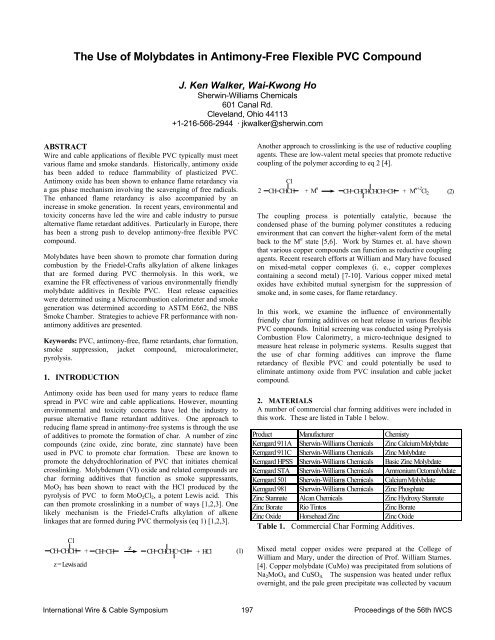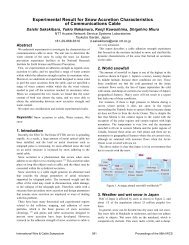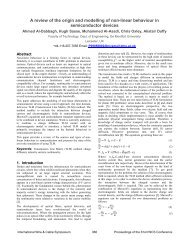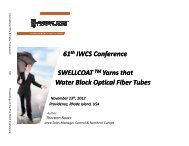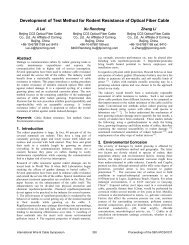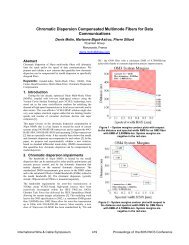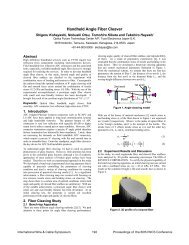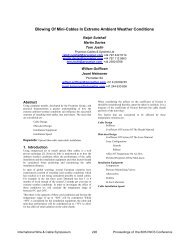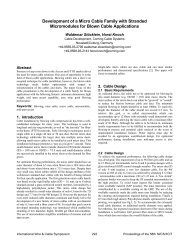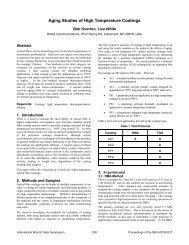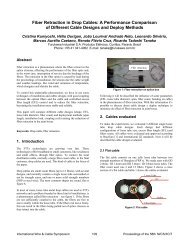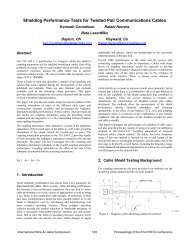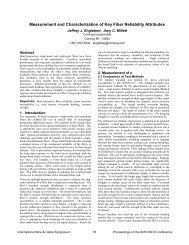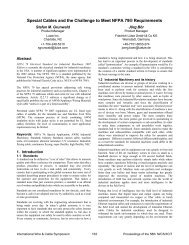The Use of Molybdates in Antimony-Free Flexible PVC Compound
The Use of Molybdates in Antimony-Free Flexible PVC Compound
The Use of Molybdates in Antimony-Free Flexible PVC Compound
Create successful ePaper yourself
Turn your PDF publications into a flip-book with our unique Google optimized e-Paper software.
<strong>The</strong> <strong>Use</strong> <strong>of</strong> <strong>Molybdates</strong> <strong>in</strong> <strong>Antimony</strong>-<strong>Free</strong> <strong>Flexible</strong> <strong>PVC</strong> <strong>Compound</strong>J. Ken Walker, Wai-Kwong HoSherw<strong>in</strong>-Williams Chemicals601 Canal Rd.Cleveland, Ohio 44113+1-216-566-2944 · jkwalker@sherw<strong>in</strong>.comABSTRACTWire and cable applications <strong>of</strong> flexible <strong>PVC</strong> typically must meetvarious flame and smoke standards. Historically, antimony oxidehas been added to reduce flammability <strong>of</strong> plasticized <strong>PVC</strong>.<strong>Antimony</strong> oxide has been shown to enhance flame retardancy viaa gas phase mechanism <strong>in</strong>volv<strong>in</strong>g the scaveng<strong>in</strong>g <strong>of</strong> free radicals.<strong>The</strong> enhanced flame retardancy is also accompanied by an<strong>in</strong>crease <strong>in</strong> smoke generation. In recent years, environmental andtoxicity concerns have led the wire and cable <strong>in</strong>dustry to pursuealternative flame retardant additives. Particularly <strong>in</strong> Europe, therehas been a strong push to develop antimony-free flexible <strong>PVC</strong>compound.<strong>Molybdates</strong> have been shown to promote char formation dur<strong>in</strong>gcombustion by the Friedel-Crafts alkylation <strong>of</strong> alkene l<strong>in</strong>kagesthat are formed dur<strong>in</strong>g <strong>PVC</strong> thermolysis. In this work, weexam<strong>in</strong>e the FR effectiveness <strong>of</strong> various environmentally friendlymolybdate additives <strong>in</strong> flexible <strong>PVC</strong>. Heat release capacitieswere determ<strong>in</strong>ed us<strong>in</strong>g a Microcombustion calorimeter and smokegeneration was determ<strong>in</strong>ed accord<strong>in</strong>g to ASTM E662, the NBSSmoke Chamber. Strategies to achieve FR performance with nonantimonyadditives are presented.Keywords: <strong>PVC</strong>, antimony-free, flame retardants, char formation,smoke suppression, jacket compound, microcalorimeter,pyrolysis.1. INTRODUCTION<strong>Antimony</strong> oxide has been used for many years to reduce flamespread <strong>in</strong> <strong>PVC</strong> wire and cable applications. However, mount<strong>in</strong>genvironmental and toxicity concerns have led the <strong>in</strong>dustry topursue alternative flame retardant additives. One approach toreduc<strong>in</strong>g flame spread <strong>in</strong> antimony-free systems is through the use<strong>of</strong> additives to promote the formation <strong>of</strong> char. A number <strong>of</strong> z<strong>in</strong>ccompounds (z<strong>in</strong>c oxide, z<strong>in</strong>c borate, z<strong>in</strong>c stannate) have beenused <strong>in</strong> <strong>PVC</strong> to promote char formation. <strong>The</strong>se are known topromote the dehydrochlor<strong>in</strong>ation <strong>of</strong> <strong>PVC</strong> that <strong>in</strong>itiates chemicalcrossl<strong>in</strong>k<strong>in</strong>g. Molybdenum (VI) oxide and related compounds arechar form<strong>in</strong>g additives that function as smoke suppressants,MoO 3 has been shown to react with the HCl produced by thepyrolysis <strong>of</strong> <strong>PVC</strong> to form MoO 2 Cl 2 , a potent Lewis acid. Thiscan then promote crossl<strong>in</strong>k<strong>in</strong>g <strong>in</strong> a number <strong>of</strong> ways [1,2,3]. Onelikely mechanism is the Friedel-Crafts alkylation <strong>of</strong> alkenel<strong>in</strong>kages that are formed dur<strong>in</strong>g <strong>PVC</strong> thermolysis (eq 1) [1,2,3].ClCH=CHCHz = Lewis acid+zCH=CH CH=CHCHC=CH + HCl (1)Another approach to crossl<strong>in</strong>k<strong>in</strong>g is the use <strong>of</strong> reductive coupl<strong>in</strong>gagents. <strong>The</strong>se are low-valent metal species that promote reductivecoupl<strong>in</strong>g <strong>of</strong> the polymer accord<strong>in</strong>g to eq 2 [4].2ClCH=CHCH+ M n CH=CHCHCHCH=CH + M n+2 Cl 2 (2)<strong>The</strong> coupl<strong>in</strong>g process is potentially catalytic, because thecondensed phase <strong>of</strong> the burn<strong>in</strong>g polymer constitutes a reduc<strong>in</strong>genvironment that can convert the higher-valent form <strong>of</strong> the metalback to the M n state [5,6]. Work by Starnes et. al. have shownthat various copper compounds can function as reductive coupl<strong>in</strong>gagents. Recent research efforts at William and Mary have focusedon mixed-metal copper complexes (i. e., copper complexesconta<strong>in</strong><strong>in</strong>g a second metal) [7-10]. Various copper mixed metaloxides have exhibited mutual synergism for the suppression <strong>of</strong>smoke and, <strong>in</strong> some cases, for flame retardancy.In this work, we exam<strong>in</strong>e the <strong>in</strong>fluence <strong>of</strong> environmentallyfriendly char form<strong>in</strong>g additives on heat release <strong>in</strong> various flexible<strong>PVC</strong> compounds. Initial screen<strong>in</strong>g was conducted us<strong>in</strong>g PyrolysisCombustion Flow Calorimetry, a micro-technique designed tomeasure heat release <strong>in</strong> polymeric systems. Results suggest thatthe use <strong>of</strong> char form<strong>in</strong>g additives can improve the flameretardancy <strong>of</strong> flexible <strong>PVC</strong> and could potentially be used toelim<strong>in</strong>ate antimony oxide from <strong>PVC</strong> <strong>in</strong>sulation and cable jacketcompound.2. MATERIALSA number <strong>of</strong> commercial char form<strong>in</strong>g additives were <strong>in</strong>cluded <strong>in</strong>this work. <strong>The</strong>se are listed <strong>in</strong> Table 1 below.Product Manufacturer ChemistyKemgard 911A Sherw<strong>in</strong>-Williams Chemicals Z<strong>in</strong>c Calcium MolybdateKemgard 911C Sherw<strong>in</strong>-Williams Chemicals Z<strong>in</strong>c MolybdateKemgard HPSS Sherw<strong>in</strong>-Williams Chemicals Basic Z<strong>in</strong>c MolybdateKemgard STA Sherw<strong>in</strong>-Williams Chemicals Ammonium OctomolybdateKemgard 501 Sherw<strong>in</strong>-Williams Chemicals Calcium MolybdateKemgard 981 Sherw<strong>in</strong>-Williams Chemicals Z<strong>in</strong>c PhosphateZ<strong>in</strong>c Stannate Alcan Chemicals Z<strong>in</strong>c Hydroxy StannateZ<strong>in</strong>c Borate Rio T<strong>in</strong>tos Z<strong>in</strong>c BorateZ<strong>in</strong>c Oxide Horsehead Z<strong>in</strong>c Z<strong>in</strong>c OxideTable 1. Commercial Char Form<strong>in</strong>g Additives.Mixed metal copper oxides were prepared at the College <strong>of</strong>William and Mary, under the direction <strong>of</strong> Pr<strong>of</strong>. William Starnes.[4]. Copper molybdate (CuMo) was precipitated from solutions <strong>of</strong>Na 2 MoO 4 and CuSO 4. <strong>The</strong> suspension was heated under refluxovernight, and the pale green precipitate was collected by vacuumInternational Wire & Cable Symposium 197 Proceed<strong>in</strong>gs <strong>of</strong> the 56th IWCS
filtration. Other mixed-metal Cu(II) oxides, CuSnO 3 (CuSn), andCuTi 3 O 7 (CuTi), were similarly prepared.All flexible <strong>PVC</strong> compounds were based on the formulation, asshown <strong>in</strong> Table 2. <strong>The</strong> <strong>PVC</strong> res<strong>in</strong>, Oxv<strong>in</strong>yl 240F, had an <strong>in</strong>herentviscosity <strong>of</strong> 1.02, a relative viscosity <strong>of</strong> 2.37, and a K value <strong>of</strong> 70.Two different plasticizers were used, dioctyl phthalate fromEastman Chemicals and Santicizer 2148, a alkyl/aryl phosphateester, from Ferro. All formulations conta<strong>in</strong>ed 50 parts <strong>of</strong> Micral9400, an untreated alum<strong>in</strong>a trihydrate from Huber.Table 2. Typical flexible <strong>PVC</strong> formulation.Ingredient Parts by weight Supplier<strong>PVC</strong> Res<strong>in</strong> 100 Oxyv<strong>in</strong>ylsT<strong>in</strong> Stabilizer 1.5 Rohm & HaasSynergist 6 VariousAlum<strong>in</strong>aTrihydrate50 HuberSanticizer 2148 50/0 FerroDioctyl Phthalate 0/50 Eastman<strong>The</strong> flexible <strong>PVC</strong> specimens were fused us<strong>in</strong>g a 75-mLBrabender Plasti-Corder Digi-System equipped with Type 6 rollerblades (3:2 speed ratio). <strong>The</strong> fusion process parameters <strong>in</strong>cluded amix<strong>in</strong>g temperature <strong>of</strong> 160 0 C and a mix<strong>in</strong>g time <strong>of</strong> 5 m<strong>in</strong>utes.<strong>The</strong> fused samples were compression molded with a Carver pressat 300 0 F.3. TEST METHODS3.1 Pyrolysis Combustion Flow CalorimeterLyon, Walters and coworkers at the Federal AviationAdm<strong>in</strong>istration Laboratory recently developed PyrolysisCombustion Flow Calorimeter (PCFC) to study, on a small scale,the FR properties <strong>of</strong> polymeric materials. Pyrolysis (condensedphase) and combustion (gas phase) processes are separatelyreproduced <strong>in</strong> a nonflam<strong>in</strong>g test. In the first step, the specimen isheated at a constant rate <strong>in</strong> a pyrolyzer and the degradationproducts are swept away by an <strong>in</strong>ert N 2 gas. <strong>The</strong> gas stream isthen mixed with oxygen <strong>in</strong> a combustion zone at 900 0 C wherethe degradation products are completely oxidized. Heat releaserates are then determ<strong>in</strong>ed by oxygen depletion. Heat releasecapacity (HRC) is def<strong>in</strong>ed as the maximum heat release ratedivided by the heat<strong>in</strong>g rate. For systems such as <strong>PVC</strong> thatexhibit two maxima, the heat release capacity is the sum <strong>of</strong>the two heat release rates. <strong>The</strong> total heat release (THR) is the<strong>in</strong>tegral <strong>of</strong> the heat release rate/time curve. Lyon and coworkershave shown for pure polymers a correlation between PCFCparameters and FR tests such as UL94, limit<strong>in</strong>g oxygen <strong>in</strong>dex andthe cone calorimeter.3.2 NBS Smoke Chamber Measurements.<strong>The</strong> smoke generated by the combustion <strong>of</strong> the plaques wasdeterm<strong>in</strong>ed by us<strong>in</strong>g the National Bureau <strong>of</strong> Standards (NBS)Smoke Chamber method, standardized <strong>in</strong> the United States asASTM-E662. Test plaques (75 x 75 x 3 mm) were subjected to aradiant heat flux <strong>of</strong> 25 kW/m 2 , and all tests were run <strong>in</strong> theflam<strong>in</strong>g mode. <strong>The</strong> maximum smoke density as well as thesmoke density at various times were recorded; average deviationsfor duplicate burns generally were ≤10%.4. RESULTS4.1 Dioctyl Phthalate Plasticized <strong>PVC</strong>In the Pyrolysis Combustion Flow Calorimeter, heat release rateis determ<strong>in</strong>ed as a function <strong>of</strong> pyrolysis temperature. Figure 1shows representative curves obta<strong>in</strong>ed with pure <strong>PVC</strong> res<strong>in</strong> as wellas a filled, DOP plasticized <strong>PVC</strong> compound (no synergist). Pure<strong>PVC</strong> res<strong>in</strong> exhibits two stages <strong>of</strong> decomposition. <strong>The</strong> first peakwith a maximum at 330 0 C corresponds to the <strong>in</strong>itialdehydrochlor<strong>in</strong>ation process that results <strong>in</strong> the formation <strong>of</strong> across-l<strong>in</strong>ked char. <strong>The</strong> second, larger peak, at approximately 480 oC corresponds to the thermal decomposition <strong>of</strong> the char layer.<strong>The</strong> pyrolysis behavior <strong>in</strong> the plasticized PVS system is somewhatdifferent. In this system, the first peak is much larger and occursat lower temperature (300 0 C) than that <strong>of</strong> the neat res<strong>in</strong>. Thispeak is likely the result <strong>of</strong> several processes <strong>in</strong>clud<strong>in</strong>g pyrolysis <strong>of</strong>plasticizer as well as the <strong>in</strong>itial pyrolysis <strong>of</strong> the <strong>PVC</strong> res<strong>in</strong>. <strong>The</strong>second peak <strong>in</strong> the plasticized system is smaller than that <strong>of</strong> theneat res<strong>in</strong> but occurs at approximately the same temperature. Inboth systems, the second peak likely corresponds to the thermaldecomposition <strong>of</strong> a <strong>PVC</strong> char. However, <strong>in</strong> the filled/plasticizedsystem, the magnitude is smaller s<strong>in</strong>ce <strong>PVC</strong> is only 50% <strong>of</strong> thetotal composition.HHR (W/g)15010050DOP <strong>PVC</strong>0150 350 550Temperature (C)<strong>PVC</strong>Figure 1. PCFC Comparison <strong>of</strong> <strong>PVC</strong> res<strong>in</strong> and DOP plasticized<strong>PVC</strong> compound.A total <strong>of</strong> 14 synergists or synergist comb<strong>in</strong>ations werecompounded <strong>in</strong>to a model flexible <strong>PVC</strong> compound. This modelcompound consisted <strong>of</strong> 50 parts dioctyl phthalate, 50 parts ATH,1.5 parts <strong>of</strong> a t<strong>in</strong> stabilizer and 6 parts <strong>of</strong> the synergist. As acontrol, the 6 parts <strong>of</strong> synergist were replaced with 6 parts <strong>of</strong>CaCO3 <strong>in</strong>ert filler. Table 3 shows PCFC data for the varioussystems. Also shown are LOI results, determ<strong>in</strong>ed accord<strong>in</strong>g toASTM D 2863.<strong>The</strong> addition <strong>of</strong> antimony oxide to the DOP plasticized compound<strong>in</strong>creased the LOI from 28 for the control compound to 37.However, the HRC and THR determ<strong>in</strong>ed by PCFC were verysimilar to that <strong>of</strong> the control compound conta<strong>in</strong><strong>in</strong>g CaCO3. <strong>The</strong>mechanism for antimony/halogen synergy is known to <strong>in</strong>volvegas phase free radical <strong>in</strong>hibition <strong>of</strong> flame reactions. <strong>The</strong>refore, itis clear that the PCFC is <strong>in</strong>sensitive to vapor phase mechanisms <strong>of</strong>flame retardancy. Lyon et. al. have discussed this aspect <strong>of</strong> PCFCand have gone on to demonstrate that the technique is sensitive tocondensed phase processes such as char formation.International Wire & Cable Symposium 198 Proceed<strong>in</strong>gs <strong>of</strong> the 56th IWCS
<strong>PVC</strong> 100DOP 50ATH 50T<strong>in</strong> Stab. 1.5Synergist 6373533CaCO3 Sb2O3 911A HPSS STA 981 911C 501HRC 206 206 336 400 479 489 462 205THR 12.4 12.5 11 10 10 10.7 10.6 11.7Peak 1 Temp 301 291 284 272 276 273 276 298Peak 1 Area 8.05 7.48 7.47 6.14 6.72 6.68 7.07 7.88Peak 3 Temp 486 483 482 481 477 489 483 483Peak 3 Area 4.33 3.71 3.41 3.73 3.24 4.03 3.47 3.94LOI3129R 2 = 0.717527258 8.5 9 9.5 10 10.5 11 11.5 12 12.5 13Total HeatLOI 28 37 30 32 33 28 29 28ZHS ZB CuMo CuSn CuTi ZnO CuMo/HPSSHRC 709 528 417 316 214 372 276THR 10.2 11.2 9.3 9.8 10.6 7.8 8.9Peak 1 Temp 268 274 265 272 281 263 270Peak 1 Area 6.3 7.32 7.06 6.58 7.17 4.79 5.63Peak 3 Temp 484 485 473 480 484 485 479Peak 3 Area 3.92 3.98 2.16 3.21 3.46 4.32 3.28Figure 2. PCFC Total Heat Release vs. LOI for DOPPlasticized <strong>PVC</strong>.600500400300DOP PlasticizerPower (DOP Plasticizer)200LOI 33 31 33 33 31 31 35100Table 3. PCFC and LOI Data for DOP Plasticized <strong>PVC</strong>.<strong>The</strong> PCFC does appear to differentiate between the other FRsynergists, all <strong>of</strong> which are believed to function by promot<strong>in</strong>gchar formation. To differ<strong>in</strong>g degrees, all <strong>of</strong> the char form<strong>in</strong>gadditives also enhanced the limit<strong>in</strong>g oxygen <strong>in</strong>dex. Of thes<strong>in</strong>gle synergist systems, the highest LOI (33) was achievedwith Kemgard STA (ammonium octomolybdate), coppermolybdate and z<strong>in</strong>c stannate. <strong>The</strong>se three also exhibited lowtotal heat release <strong>in</strong> the PCFC. Figure 2 demonstrates thecorrelation between LOI and THR for the 14 antimony-freesystems.<strong>The</strong> PCFC heat release curves themselves provided <strong>in</strong>terest<strong>in</strong>gcomparisons between the various synergists. All synergistsreduced the char formation temperature compared to the control,with ZnO show<strong>in</strong>g the greatest reduction (see Table 1). ZnO isknow to catalyze the dehydrochlor<strong>in</strong>ation <strong>of</strong> <strong>PVC</strong> and dim<strong>in</strong>ishthermal stability. <strong>The</strong> effect <strong>of</strong> ZnO on pyrolysis <strong>of</strong> <strong>PVC</strong> can beseen <strong>in</strong> Figure 3.<strong>The</strong> onset <strong>of</strong> pyrolysis <strong>in</strong> the ZnO system is actually precededby the formation <strong>of</strong> non-combustible gasses (HCl) that appearsas a negative heat release rate. <strong>The</strong> subsequent combustion peakis much sharper and lower <strong>in</strong> area than the control. Interest<strong>in</strong>glythe second peak attributed to thermal decomposition <strong>of</strong> thecharred <strong>PVC</strong> is not affected by the presence <strong>of</strong> ZnO.Two <strong>of</strong> the best perform<strong>in</strong>g systems, KG STA and coppermolybdate are shown <strong>in</strong> Figure 4, along with the control.0-100-200150 200 250 300 350 400 450 500 550 600TemperatureContr olFigure 3. PCFC Curves <strong>of</strong> DOP Plasticized <strong>PVC</strong>: ZnO vs.Control.500450400350300250200150100500150 200 250 300 350 400 450 500 550 600 650ZnOTemperature (C)CaCO3 Filler Copper Molybdate KG STAFigure 4. PCFC curves <strong>of</strong> DOP plasticized <strong>PVC</strong>: KG STA andcopper molybdate vs. control.International Wire & Cable Symposium 199 Proceed<strong>in</strong>gs <strong>of</strong> the 56th IWCS
Like ZnO, these additives reduced the char formationtemperature and also the area <strong>of</strong> the first pyrolysis peak.However, unlike ZnO, both also reduced the area <strong>of</strong> the secondpyrolysis peak, <strong>in</strong>dicat<strong>in</strong>g that both additives promote theformation <strong>of</strong> a more thermally stable char. KG STA was moreeffective than copper molybdate <strong>in</strong> decreas<strong>in</strong>g the total heatrelease from the first pyrolysis step, but copper molybdate wasmore effective <strong>in</strong> decreas<strong>in</strong>g the area <strong>of</strong> the second peak. Thisdifference <strong>in</strong> behavior suggests differ<strong>in</strong>g mechanisms that maygive rise to further synergy.<strong>The</strong> potential synergy through the use <strong>of</strong> two char form<strong>in</strong>gadditives can been seen by exam<strong>in</strong>ation <strong>of</strong> the systemconta<strong>in</strong><strong>in</strong>g KG HPSS and copper molybdate. This comb<strong>in</strong>ationachieved an LOI <strong>of</strong> 35, approach<strong>in</strong>g that <strong>of</strong> the antimony oxidesystem. <strong>The</strong> KG HPSS/copper molybdate system also exhibitedthe lowest THR <strong>of</strong> any <strong>of</strong> the systems exam<strong>in</strong>ed. Figure 5presents the PCFC curves for KG HPSS, copper molybdate andthe comb<strong>in</strong>ation <strong>of</strong> the two. It can be seen that first pyrolysispeak with the comb<strong>in</strong>ation <strong>of</strong> KG HPSS and copper molybdatewas lower <strong>in</strong> area than either <strong>of</strong> the two materials alone. <strong>The</strong>area <strong>of</strong> the second peak for the comb<strong>in</strong>ation was <strong>in</strong>termediatethat <strong>of</strong> the two additives alone.thermal stability <strong>of</strong> <strong>PVC</strong> char. This is also consistent with theuse <strong>of</strong> Santicizer 2148 to lower smoke <strong>in</strong> <strong>PVC</strong> plenum cablejacket formulations.Both systems exhibited two peaks. <strong>The</strong> first peak for bothsystems occurred at approximately the same temperature. <strong>The</strong>peak height and peak were slightly lower for the sampleconta<strong>in</strong><strong>in</strong>g the phosphate ester. However, a shift toward highertemperature was observed for the second peak <strong>in</strong> the systemconta<strong>in</strong><strong>in</strong>g 2148. <strong>The</strong> peak area was also lower. S<strong>in</strong>ce this peakis believed to correspond to the thermal decomposition <strong>of</strong> the<strong>PVC</strong> char, we conclude that the phosphate moiety <strong>in</strong>creases thethermal stability <strong>of</strong> <strong>PVC</strong> char. This is also consistent with theuse <strong>of</strong> Santicizer 2148 to lower smoke <strong>in</strong> <strong>PVC</strong> plenum cablejacket formulations.18 016 014 012 010 0806040204003500150 200 250 300 350 400 450 500 550 600 650Temperature (C)300DOP Con t r ol2148 ControlHRR (W/g)250200150100500150 200 250 300 350 400 450 500 550 600 650Temperature (C)CaCO3 HPSS CuMo HPSS/CuMo BlendFigure 5. PCFC Curves <strong>of</strong> DOP Plasticized <strong>PVC</strong>: KG HPSS,CuMo and Blend vs. Control.4.2 Phosphate Ester Plasticized <strong>PVC</strong>A number <strong>of</strong> FR plasticizers are available <strong>in</strong> the marketplace,<strong>in</strong>clud<strong>in</strong>g brom<strong>in</strong>ated phthalates, phosphate esters etc. In thisstudy we utilized the PCFC to study the <strong>in</strong>fluence <strong>of</strong> Santicizer2148 on heat release rates <strong>in</strong> flexible <strong>PVC</strong> systems. Figure 6compares PCFC curves for two flexible <strong>PVC</strong> systems. Onesystem was compounded with 50 phr DOP and the secondsystem was compounded with 50 phr Santicizer 2148. Bothsystems also conta<strong>in</strong>ed 50 phr ATH and 6 phr CaCO3.Both systems exhibited two peaks. <strong>The</strong> first peak for bothsystems occurred at approximately the same temperature. <strong>The</strong>peak height and peak were slightly lower for the sampleconta<strong>in</strong><strong>in</strong>g the phosphate ester. However, a shift toward highertemperature was observed for the second peak <strong>in</strong> the systemconta<strong>in</strong><strong>in</strong>g 2148. <strong>The</strong> peak area was also lower. S<strong>in</strong>ce this peakis believed to correspond to the thermal decomposition <strong>of</strong> the<strong>PVC</strong> char, we conclude that the phosphate moiety <strong>in</strong>creases theFigure 6. PCFC Curves <strong>of</strong> DOP and Santicizer 2148Plasticized <strong>PVC</strong>.A total <strong>of</strong> 14 synergists or synergist comb<strong>in</strong>ations werecompounded <strong>in</strong>to a model flexible <strong>PVC</strong> compound conta<strong>in</strong><strong>in</strong>gSanticizer 2148 plasticizer. As <strong>in</strong> the earlier study, the modelcompound also conta<strong>in</strong>ed 50 parts ATH, 1.5 parts <strong>of</strong> a t<strong>in</strong>stabilizer and 6 parts <strong>of</strong> the synergist. As a control, the 6 parts<strong>of</strong> synergist were replaced with 6 parts <strong>of</strong> CaCO3 <strong>in</strong>ert filler.Table 4 shows PCFC data for the various systems along withLOI results, determ<strong>in</strong>ed accord<strong>in</strong>g to ASTM D 2863.Table 4. PCFC and LOI Data for Santicizer 2148 plasticized<strong>PVC</strong> compounds.Number CaCO3 Sb2O3 911A HPSS STA 981 911C ZHS ZBHRC 236 277 394 347 289 571 400 440 388Total Heat 14.3 13.2 12.7 11.8 11.7 11.4 12.3 11.6 11.6Peak 1 Temp 302 307 285 290 295 275 287 280 278Peak 1 Area 8.71 8.18 7.93 7.24 8.25 7.28 7.81 7.33 7.24Peak 3 Temp 475 477 480 481 480 484 483 487 486Peak 3 Area 5.6 5.06 4.81 4.55 3.5 4.14 4.53 4.31 4.38LOI 33 34 32 31.5 37 30.5 32 31.5 30.5Number CuMo CuSn CuTi ZnOCuMo/HPSS CuMo/STACuMo/CuSn CuMo/CuTiHRC 285 367 317 519 301 307 331 334Total Heat 10 10.7 12.4 10.6 11 10.2 11.1 10.9Peak 1 Temp 280 276 287 270 280 285 277 278Peak 1 Area 7.27 7.25 8.16 6.5 7.49 7.28 7.92 7.86Peak 3 Temp 481 486 483 486 482 482 485 485Peak 3 Area 2.72 3.49 4.26 4.09 3.53 2.91 3.16 3.03LOI 32 30.5 33 29.5 33 32 32 32International Wire & Cable Symposium 200 Proceed<strong>in</strong>gs <strong>of</strong> the 56th IWCS
<strong>The</strong>re were several <strong>in</strong>terest<strong>in</strong>g features <strong>in</strong> the LOI results. <strong>The</strong>LOI for the control was much higher than that <strong>of</strong> the DOPcontrol (33 vs. 28). This result clearly demonstrates the FReffectiveness <strong>of</strong> the phosphate ester plasticizer. This is likelydue to the enhanced thermal stability <strong>of</strong> the <strong>PVC</strong> char. Anunexpected observation was that antimony oxide onlymarg<strong>in</strong>ally <strong>in</strong>creased the LOI. This result is not well understoodand further work is needed to exam<strong>in</strong>e the function <strong>of</strong> antimonyoxide at different levels.30025020015 010 050All <strong>of</strong> the other char form<strong>in</strong>g synergists lowered the THRcompared to the control. However, most <strong>of</strong> the synergistssignificantly <strong>in</strong>creased the HRC – the two with the least effectbe<strong>in</strong>g KG STA and copper molybdate. Also to vary<strong>in</strong>g degrees,all <strong>of</strong> the synergists shifted the first pyrolyis peak to lowertemperatures. ZnO showed the largest shift <strong>in</strong> peak temperaturewhile KG STA showed the smallest temperature shift.Nearly all <strong>of</strong> the synergists lowered the LOI compared to thecontrol. It appears that the lowest LOI’s were observed <strong>in</strong> thesystems that showed the largest shift <strong>in</strong> peak temperature for thefirst pyrolysis. Figure 7 shows that there appears to be acorrelation between the temperature <strong>of</strong> the first pyrolysis peakand LOI. <strong>The</strong> KG STA system proved to be the only systemwith an LOI higher than the control (37 vs. 34) and was alsohigher than that <strong>of</strong> the antimony oxide system. KG STA wasalso the additive with the least affect on peak temperature.LOI3836343230R 2 = 0.63020200 250 300 350 400 450 500 550 600Temperat ure ( C)CaCO3 HPSS STA CuM oFigure 8. PCFC curves <strong>of</strong> 2148 plasticized <strong>PVC</strong>: KG HPSS,KG STA and CuMo vs. Control.4.3 NBS Smoke – Phosphate Ester PlasticizerInorganic molybdates are the <strong>in</strong>dustry standard for smokesuppression <strong>in</strong> <strong>PVC</strong>. <strong>The</strong> maximum smoke density, determ<strong>in</strong>edaccord<strong>in</strong>g to ASTM E662 is shown for five samples, allconta<strong>in</strong><strong>in</strong>g 50 phr Santicizer 2148 and 50 phr ATH. <strong>The</strong>addition <strong>of</strong> antimony oxide <strong>in</strong>creased the maximum smokedensity developed. when compared to the control compound.<strong>The</strong> effect <strong>of</strong> antimony oxide on smoke development <strong>in</strong> <strong>PVC</strong> iswell known and has been attributed its vapor phase mechanism<strong>of</strong> action. All <strong>of</strong> the other molybdate based synergistssignificantly lowered the maximum smoke density to vary<strong>in</strong>gdegrees. Figure 9 shows the effectiveness <strong>of</strong> three molybdatebase materials, KG HPSS, KG STA and copper molybdate.2826270 275 280 285 290 295 300Peak Temperature (C)700NBS Smoke DmaxFigure 7. Peak temperature vs. LOI for Santicizer 2148plasticized <strong>PVC</strong> compounds.<strong>The</strong> best perform<strong>in</strong>g system, KG STA, is compared to KGHPSS and copper molybdate <strong>in</strong> Figure 8. <strong>The</strong> majordist<strong>in</strong>guish<strong>in</strong>g feature is the temperature <strong>of</strong> the first pyrolysisreaction. <strong>The</strong> total heat associated with the first peak wasactually lowest with KG HPSS, the system with the lowest LOI.All three <strong>of</strong> these additives did reduce total heat associated withthe second pyrolysis peak, aga<strong>in</strong> <strong>in</strong>dicat<strong>in</strong>g that these additivescan produce a more thermally stable char. <strong>The</strong> most effectiveadditive <strong>in</strong> terms <strong>of</strong> the the second pyrolysis peak was veryclearly copper molybdate.6005004003002001000Cont rol Sb2O3 HPSS STA CuMoFigure 9. Maximum Smoke Density for 2148 plasticized <strong>PVC</strong>.<strong>The</strong> most effective smoke suppressant <strong>in</strong> the study was coppermolybdate. As shown <strong>in</strong> Figure 8, copper molybdate was alsomost effective <strong>in</strong> lower<strong>in</strong>g the total heat associated with thethermal decomposition <strong>of</strong> the <strong>PVC</strong> char.International Wire & Cable Symposium 201 Proceed<strong>in</strong>gs <strong>of</strong> the 56th IWCS
5. CONCLUSIONSPyrolysis Combustion Flow Calorimetry has been used to studythe <strong>in</strong>fluence <strong>of</strong> various additives on heat release rate <strong>in</strong>antimony- free flexible <strong>PVC</strong> systems. In DOP plasticized <strong>PVC</strong>,nearly all <strong>of</strong> the char promot<strong>in</strong>g additives lowered total heatrelease and also <strong>in</strong>crease LOI. Additives based on coppermolybdate, ammonium octomolybdate and basic z<strong>in</strong>c molybdatechemistries appeared to be most effective. However, at equalload<strong>in</strong>g no s<strong>in</strong>gle chemistry could achieve the same LOI asantimony oxide.PCFC studies show that plasticized <strong>PVC</strong> exhibits two stages <strong>of</strong>decomposition. <strong>The</strong> major heat release occurs at roughly 300 o Cis likely the result <strong>of</strong> several processes <strong>in</strong>clud<strong>in</strong>g pyrolysis <strong>of</strong>plasticizer as well as the <strong>in</strong>itial pyrolysis <strong>of</strong> the <strong>PVC</strong> res<strong>in</strong>. <strong>The</strong>second peak occurr<strong>in</strong>g at approximately 475o C is smaller andlikely corresponds to the thermal decomposition <strong>of</strong> a <strong>PVC</strong> char.While most additives appeared to reduce heat release dur<strong>in</strong>g the<strong>in</strong>itial pyrolysis <strong>of</strong> <strong>PVC</strong>, copper molybdate, and to a lesserextent ammonium octomolybdate, was notably effective atlower<strong>in</strong>g the heat release due to the thermal decomposition <strong>of</strong>char. This likely accounts for their effectiveness for smokesuppression. Some synergy between char form<strong>in</strong>g additives wasnoted and should be <strong>in</strong>vestigated further. This synergy is likelydue to differences <strong>in</strong> char formation mechanisms.<strong>The</strong> use <strong>of</strong> an alkyl/aryl phosphate ester plasticizer, rather thanan octyl phthalate, does dramatically <strong>in</strong>crease LOI. This is dueto the <strong>in</strong>fluence <strong>of</strong> the phosphate moiety on char formation.<strong>Antimony</strong> oxide does not appear to significantly enhance LOIwhen used <strong>in</strong> comb<strong>in</strong>ation with the phosphate ester. Thissuggests that the FR effects <strong>of</strong> these materials are not additive.Similarly, most <strong>of</strong> the char form<strong>in</strong>g additives actuallydim<strong>in</strong>ished LOI. Of the char form<strong>in</strong>g additives, onlyammonium octomolybdate improved LOI. In fact, when used <strong>in</strong>comb<strong>in</strong>ation with a phosphate ester plasticizer, ammoniumoctamolybdate will produce an LOI greater than that <strong>of</strong>antimony oxide.Because <strong>of</strong> its vapor phase mechanism <strong>of</strong> action, the use <strong>of</strong>antimony oxide <strong>in</strong> <strong>PVC</strong> results <strong>in</strong> high levels <strong>of</strong> smoke. On theother hand, molybdates are the <strong>in</strong>dustry standard for smokesuppression and have been used <strong>in</strong> low smoke <strong>PVC</strong> applicationsfor many years. <strong>The</strong> development <strong>of</strong> a low-smoke, antimonyfree<strong>PVC</strong> compound that relies on molybdate promoted charformation would be a significant advancement to the wire andcable <strong>in</strong>dustry.7. REFERENCES1. Starnes, W. H., Jr.; Edelson, D. Macromolecules 1979, 12,797.2. Starnes, W. H. Jr.; Wescott, L. D., Jr.; Reents, W. D., Jr.;Cais, R. E.; Villacorta, G. M.; Plitz, I. M.; Anthony, L. J.In Polymer Additives; Kresta, J. E., Ed.; Plenum: NewYork, 1984; p 237.3. Wescott, L. D., Jr.; Starnes, W. H., Jr.; Mujsce, A. M.;L<strong>in</strong>xwiler, P. A. J. Anal. Appl. Pyrol. 1985, 8, 163.4. Pike, R. D.; Starnes, W.H., Jr.; Jeng, J. P.; Bryant, W. S.;Kourtesis, P.; Adams, C. W.; Bunge, S. D.; Kang, Y. M.;Kim, A. S.; Kim, J. H.; Macko, J. A.; O’Brien, C. P.Macromolecules 1997, 30, 6957.5. Lattimer, R. P.; Kroenke, W. J. J. Appl. Polym. Sci. 1981,26, 1191.6. Lattimer, R. P.; Kroenke, W. J. In Analytical Pyrolysis:Techniques and Applications; Voorhees, K. J., Ed.;Butterworths: Woburn, MA, 1984; p 453.7. Starnes, W. H., Jr.; Pike, R. D.; Cole, J. R.; Doyal, A. S.;Kiml<strong>in</strong>, E. J.; Lee, J. T.; Murray, P. J.; Qu<strong>in</strong>lan, R. A.;Zhang, J. Polym. Degrad. Stab. 2003, 82, 15.8. Starnes, W. H., Jr.; Pike, R. D.; Brown, A. H.; Fuller, T.W.; Qu<strong>in</strong>lan, R. A.; Showalter, T. B.; Taylor, K. M.;Zhang, J. Polym. Mater. Sci. Eng. 2004, 91, 215.9. Starnes, W. H., Jr.; Pike, R. D.; Brown, A. H.; Fuller, T.W.; Lee, J. T.; Qu<strong>in</strong>lan, R. A.; Showalter, T. B.; Taylor, K.M.; Zhang, J. In Proceed<strong>in</strong>gs, 32 nd Annual Conference <strong>of</strong>the North American <strong>The</strong>rmal Analysis Society (2004);Symposium on Flame Retardancy, Paper No. 1.10. Starnes, W. H., Jr.; Pike, R. D.; Brown, A. H.; Lee, J. T.;Showalter, T. B.; Taylor, K. M.; Zhang, J. In Proceed<strong>in</strong>gs,Additives 2004 Conference; Executive ConferenceManagement: Plymouth, MI, 2004; Chapter 1.6. ACKNOWLEDGEMENTS<strong>The</strong> authors would like to thank Pr<strong>of</strong>essors William Starnes andRobert Pike for the samples <strong>of</strong> copper mixed metal oxides andfor technical disscusions.International Wire & Cable Symposium 202 Proceed<strong>in</strong>gs <strong>of</strong> the 56th IWCS
8. AUTHORSMr. Wai-Kwong HoDr. J. Ken WalkerKen Walker is a staff scientist with the Sherw<strong>in</strong>-WilliamsCompany. He graduated from Boston University <strong>in</strong> 1980 with aPh. D. <strong>in</strong> physical chemistry and has 25 years <strong>of</strong> <strong>in</strong>dustrialresearch experience with both Diamond Shamrock Corp. andSherw<strong>in</strong>-Williams. For the past six years, Ken has directed theR&D effort for the Sherw<strong>in</strong>-Williams Chemical Bus<strong>in</strong>ess Unit.Mr. Wai-Kwong Ho is a scientist with the Sherw<strong>in</strong>-WilliamsCompany. He received his B.S. <strong>in</strong> Chemical Eng<strong>in</strong>eer<strong>in</strong>g fromPolytechnic University. Wai-Kwong has worked for more than20 years <strong>in</strong> the field <strong>of</strong> plastics, chemicals, adhesives, pa<strong>in</strong>ts andcoat<strong>in</strong>gs. Wai-Kwong and Ken are co-<strong>in</strong>ventors <strong>of</strong> a costefficient ammonium octoamolybdate (Kemgard STA) and othersmoke suppressants.International Wire & Cable Symposium 203 Proceed<strong>in</strong>gs <strong>of</strong> the 56th IWCS


